Community-led water system in historic Stanislaus town struggles to supply locals
The story was originally published by the The Modesto Bee with support from our 2025 CA Fellowship.
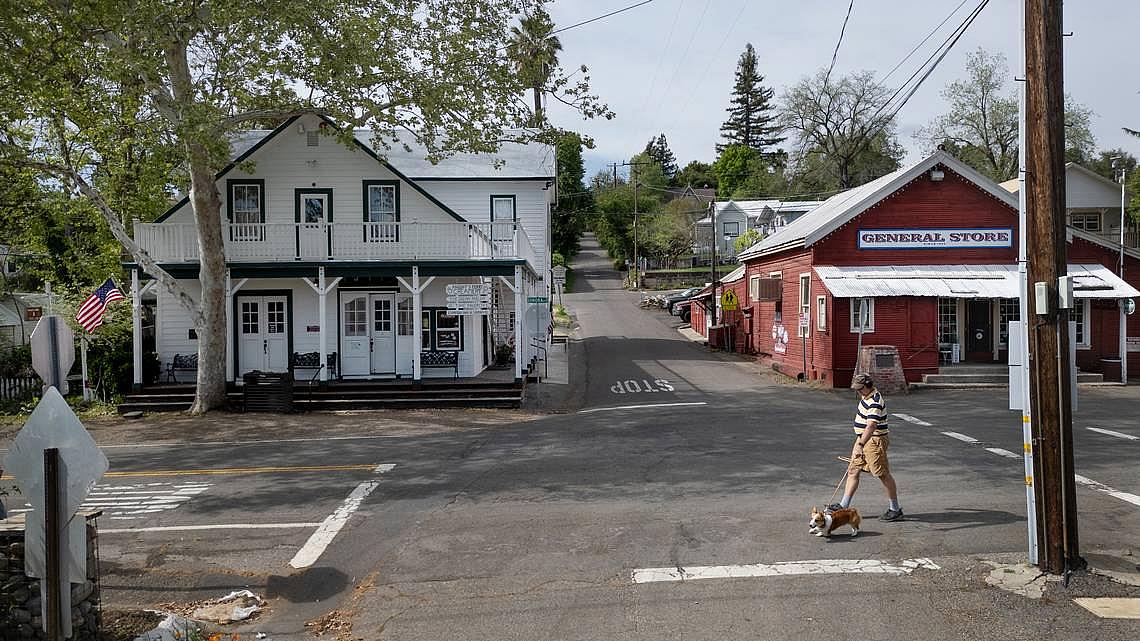
Main Street in Knights Ferry, Wednesday, April 16, 2025.
Andy Alfaro aalfaro@modbee.com
Knights Ferry has a major drinking water problem in its small water system, and it’s had it for a long time. The residents have largely learned to live with the near constant leaks, equipment failures and sporadic shutoffs.
The community was established in the 1850s on the northeastern edge of Stanislaus County. Home to the longest covered bridge west of the Mississippi and a park run by the Army Corps of Engineers, it’s a destination by out-of-towners for recreational opportunities and preserved Gold Rush-era history.
But continuous issues with disrepair and leaks in its community-led water service have the system’s future in flux.
The water system serves around 168 customers and has 67 connections, one of which is Knights Ferry Elementary School. The Knights Ferry Community Service District (KFCSD) was created in 1970 to help supply water to the community and consists of a five-member board of volunteers.
Juan Cano, a community development manager for the North Central Valley at Self-Help Enterprises, works with disadvantaged rural communities to address water and sewer infrastructure.
“You have these small communities, with these volunteer boards, and these communities, just like any other water system, run into issues like capacity or contamination, older equipment, things like that,” he said. “They need a lot of work and assistance to address these issues.”
In 2022, a Stanislaus County review of KFCSD noted that the Oakdale Irrigation District provides water from March through October via pipeline, and from November through February via pumps from the Stanislaus River.
The leaks: Fix one, another appears
Dolly Haskell has lived in Knights Ferry for 25 years. She’d been visiting the town in the summers since she was a child, and her family slowly migrated there. Now she runs the volunteer post office off Main Street and lives up the hill.
“Unfortunately, the lines pop two, three, four times a year,” she said. “And if they fix one, it springs another.”
In October, the Knights Ferry Municipal Advisory Committee’s minutes noted that an eight-inch pipeline had failed and was “currently losing 40 gallons per minute of treated water.” Self-Help Enterprises fixed the leak at the Sonora Road Bridge, which was brought to its attention in July and resolved in November.
“They did have a pretty significant few leaks,” said Jessi Snyder, Self-Help Enterprises project manager.
Diane Noon moved from Oakdale to Knights Ferry in the 1990s and walks home from her job at the Elementary School to her house regularly. “I’ve just been walking here, and there’s a leak on the road,” Noon said about water that had bubbled up through the asphalt in the middle of a neighborhood street. “It’s been there all year and they don’t have money to fix it.”
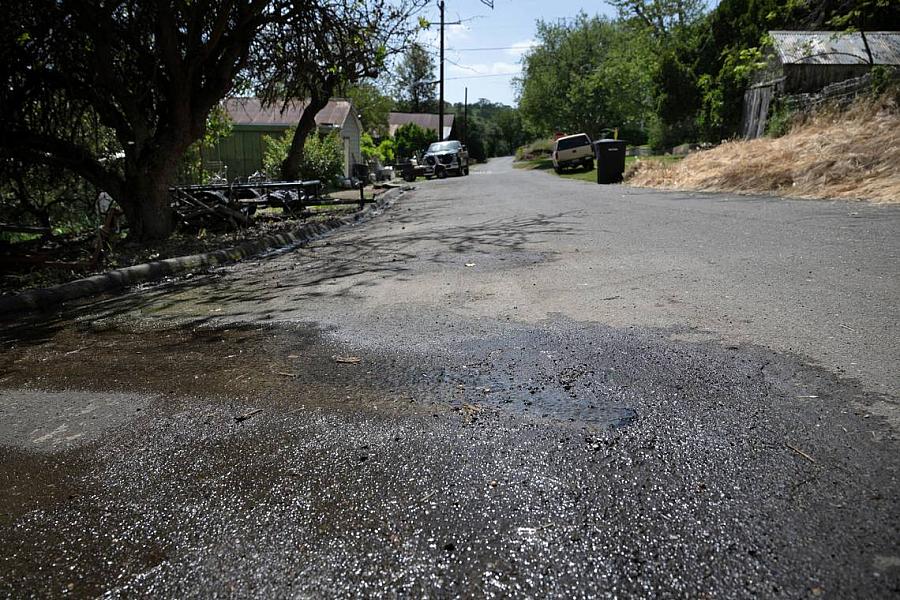
Water bubbles up from the asphalt on Vantine Street in Knights Ferry, Wednesday, April 16, 2025.
Andy Alfaro aalfaro@modbee.com
Due to ongoing leaks, the system is forced to run its water treatment plant at a higher water pressure to meet demand, according to the county’s sanitary survey record.
Some of the leaks are suspected to be a result of heavy trucks trundling along the historic roads, putting unexpected pressure on the pipes.
“The [water] system is old, and it’s not down there all that deep,” Haskell said, adding that the vibration from the trucks causes strain on the pipes.
She said she believes the large trucks carrying gravel are associated with a construction project at the Goodwin Dam Recreation Area in Tuolumne County.
Haskell said the federal government has blocked weight restrictions on vehicles because Main Street is used as an evacuation route. However, local ordinances should be able to create a permitting system for emergency vehicles while putting a general weight restriction on the road when in nonemergency use.
Other leaks may be caused by corrosion or vegetation that grows along the pipes, according to a 2024 county survey.
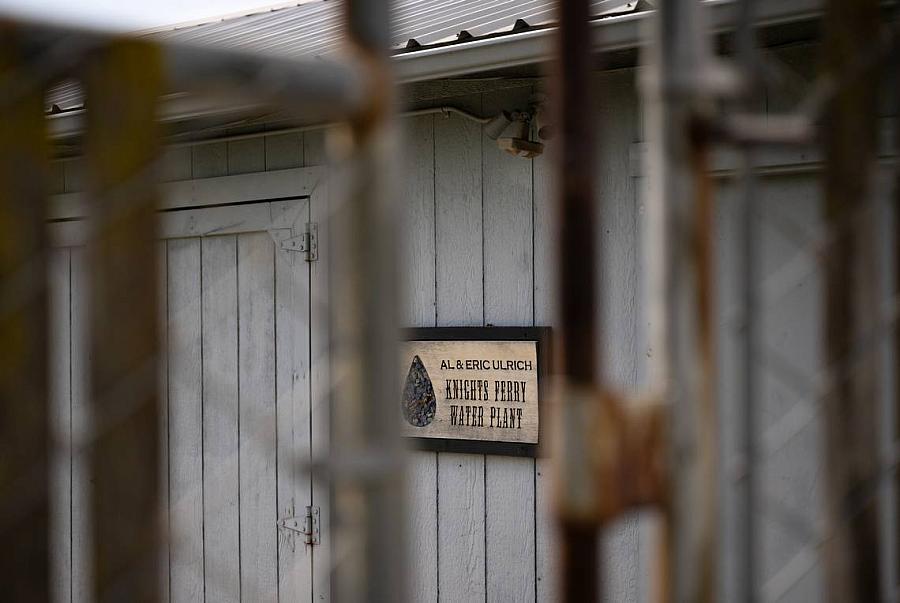
Knights Ferry water plant in Knights Ferry, Wednesday, April 16, 2025.
Andy Alfaro aalfaro@modbee.com
Water treatment plant well past life expectancy
Snyder learned through working with KFCSD on the Sonora Road leak that it had a State Water Control Board grant, but it couldn’t implement it, so Self-Help Enterprises stepped in again to assist with planning.
“That project has more to do with their water treatment plant — they need some reassessment and some upgrades,” she said.
The water treatment plant, put in place around 2000 using state funding, is now 10-15 years past its useful life expectancy, according to the State Water Control Board’s listed equipment expectations.
The State Water Control Board’s Office of Sustainable Water Solutions granted KFCSD $735,500 in August to address water quality violations, help replace old parts and assist in meeting the “lead copper rule,” which requires water systems to track the lead and copper coming out of customers’ taps and address any issues.
The upgrades could take three to five years to complete, even if everything runs smoothly, Cano said.
Rachel Reiss, a senior registered environmental health specialist for the county, informed KFCSD that there were significant issues with maintenance, storage and distribution of their water treatment plant at a KFMAC meeting.
“Knights Ferry CSD water system inspections have documented substantial infrastructure deficiencies in 2021 and 2024,” the county responded in an email.
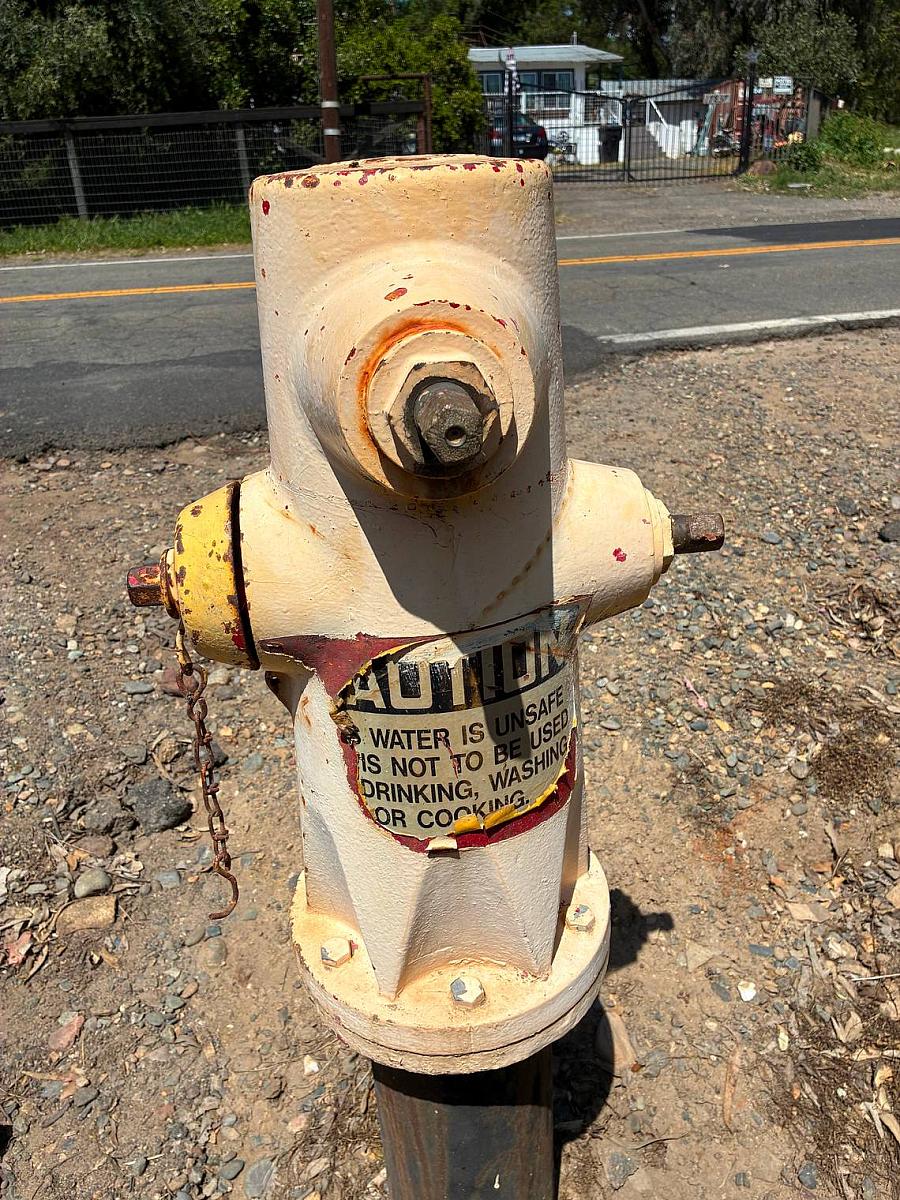
Main Street in Knights Ferry, Wednesday, April 16, 2025.
Kathleen Quinn kquinn@modbee.com
Water quality: ‘I guess I built an immunity’
Snyder said the water quality concerns stemmed from water treatment byproducts. “When you treat surface water with chlorine, you can end up with some toxic byproducts that happen,” she said
Chlorine is used as a disinfectant for surface water and in high enough levels, byproducts from the treatment can result in an increased risk of cancer, anemia, liver, kidney or central nervous system issues.
Its latest sanitary survey from the county showed it tested at the maximum contaminant level for drinking water for the carcinogens dichloropropene, carbon tetrachloride and vinyl chloride – byproducts of the chlorination process. It was also at the maximum contamination level for 1,2,3 TCP in 2022, an industrial solvent and degreaser found at hazardous waste sites – but there is no record of retesting since.
Haskell said when she came here as a child, the water was coming straight from the river with no filters. She said she loves the water and trusts it more than bottled water. “Every now and again, there’s been a level of this or a level of that,” she said. “I guess I built an immunity up like a lot of people did.”
Though Noon said she hasn’t received a notice on potential contaminants in a few years, she doesn’t drink it and has purchased her own water bottles since. “Anybody who knows anything doesn’t drink the water,” she said. “But I have younger grandchildren and they’re like ‘Oh it’s fine,’ and I’m like ‘No, it’s not – don’t drink that water.’”
Storage issues make wildfire response a concern
A 30,000-gallon storage tank was leaking so bad it had to be taken out of service. A 110,000-gallon tank became the sole storage for treated water, according to county records. This puts them at risk of being unable to respond to wildfires, which the area is prone to.
“We use domestic water for fire, so if we have a fire, the domestic water is going to go down,” Haskell said. “We need a fire system, we don’t have it – we’ve never had the money to put in a separate system.”
A sanitary survey from August 2024 noted several deficiencies in the water system including, but not limited to:
- Exposed but “de-energized” wiring,
- A cracked electronics board that prevented an alarm from sounding, which required manual daily checks of turbidity,
- A failure of an automatic function, which required the operator to perform backwash manually to routinely clean the filter,
- An irreparable sedimentation analyzer,
- A lack of fuel for their functioning back-up generator
- An emergency notification plan that did not meet state standards
- Absence of a resiliency plan despite having previous public safety shut-off events and several nearby wildfires.
In the 60 days before the county survey in August 2024, there were two water outages due to water line issues.
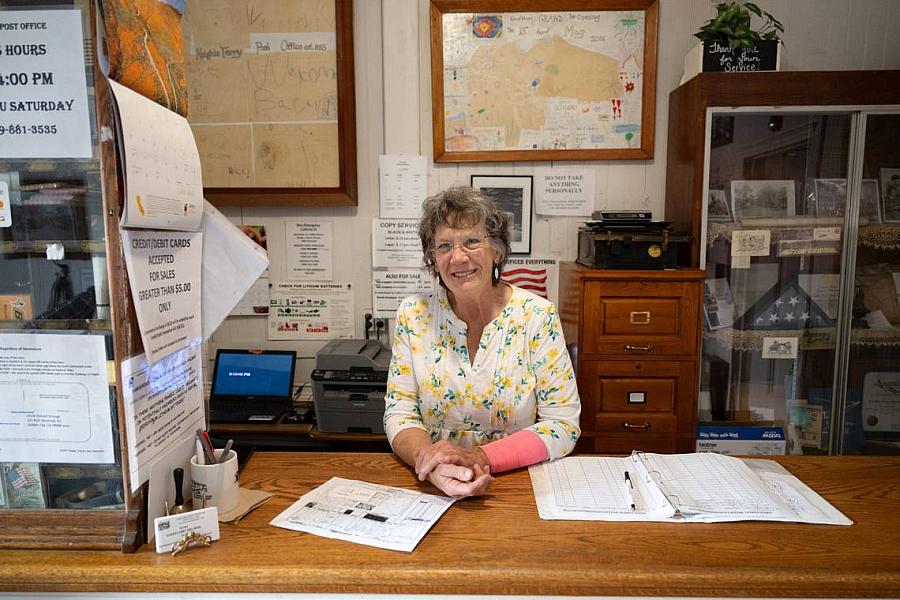
Dolly Haskell staffs the post office on Main Street in Knights Ferry, Wednesday, April 16, 2025.
Andy Alfaro aalfaro@modbee.com
Haskell said she can tell when a water shutoff is about to happen. She gets a drop in water pressure and that tells her the line is gone and it won’t take long before the water is off.
“The problem is they don’t get the neighbors notified a lot of the time,” she said. “Suddenly the water is off and everybody is going ‘What the heck?’ And they don’t know how long it’s going to be off, they don’t know why it’s off – it’s just off.”
Some small community water districts, like this one, aren’t regulated by the State directly and are instead overseen by a Local Primacy Agency run by the county.
“Local Primacy Agencies serve as the boots-on-the-ground regulators for small systems in rural and semi-rural communities that would otherwise be difficult for the State to monitor directly,” said an email sent to The Bee by the county’s spokesperson. “LPAs bring local knowledge, quicker response times, and tailored support, helping ensure safe and reliable drinking water for California’s smaller populations.”
Stefan Cajina, the North Coastal section chief of the division for drinking water at the State Water Control Board, said that though the county is the first point of regulation, the county itself is regulated annually at the state level to ensure drinking water standards are met.
Where things stand
The KFCSD has no office, phone or high-speed internet, according to KFMAC minutes.
Cajina said issues like this are typical of small water systems that are isolated from larger, more robust systems.
“It really does tend to be the unincorporated areas that have small systems that just don’t have the economies of scale – either the capital resources, or the onboard technical expertise or legal or financial expertise – to navigate these issues,” he said. “It’s really, really hard to be a small water system.”
The small water system relies heavily on grant funding, which it didn’t get in 2020 due to its former chair, Eric Ulrich, being terminally ill, according to minutes by the KFMAC from Oct. 24, 2024.
In larger systems, water providers can raise rates to cover the cost of new infrastructure or maintaining what’s already there, but with how small the customer base is for Knights Ferry, water prices can be raised only so high.
“There’s only around 100 residents in this community. What are you going to charge them to make enough money to put a million dollar system in? It’s not going to happen – it’s all they can do to keep it maintained,” Haskell said.
Kathleen Feichtner, chair of KFCSD, responded to The Bee in an email: “You are correct in the acknowledgment of the existence of concerns about our water distribution system. However we are currently working with the state and consulting firm to resolve these problems and have decided at least at this time to not provide any further comments on the matter.”
Haskell worries about the long-term future of water in the small town. There’s been talk about another water district taking over, or even shutting the system down, she said.
“What are you going to do with a town like this? How are you? You can’t do anything if you have no water,” she said. “Where we’re considered a ghost town on the map, we will in fact be a ghost town.

